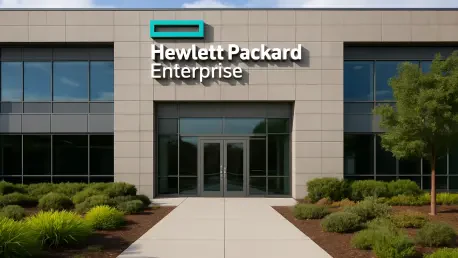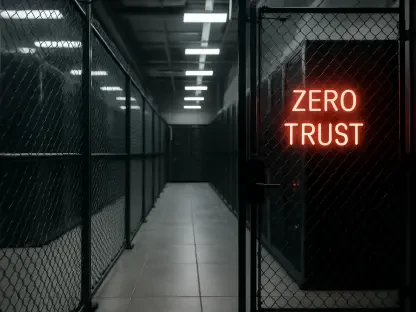Hewlett Packard Enterprise (HPE) finds itself at a defining moment with the release of its fiscal 2023 third-quarter earnings, where the interplay of cutting-edge innovation and lingering traditional struggles paints a complex picture of transformation. As technology races forward, HPE is staking its claim in high-growth domains like artificial intelligence (AI) and edge computing, areas poised to shape the future of enterprise solutions. Yet, the shadow of declining legacy hardware segments and persistent macroeconomic pressures raises questions about the sustainability of this shift. This tension between emerging opportunities and entrenched challenges offers a compelling narrative, inviting a closer examination of how HPE is navigating these dual realities. With strategic bets on next-generation technologies, the company’s latest financials provide a window into whether it can outpace its hurdles and solidify its standing in a rapidly evolving industry.
Surge in Next-Generation Solutions
AI and High Performance Computing: Investing for the Future
HPE’s High Performance Computing & AI (HPC & AI) segment emerges as a critical piece of its long-term vision, even as it grapples with near-term financial strain in the third quarter of fiscal 2023. Revenue in this segment inched up by a modest 1% year-over-year to $836 million, or 3% when adjusted for constant currency, reflecting a cautious but steady climb. However, profitability took a hit, with the operating profit margin slipping to a negative -0.8%, a stark contrast to the 3.4% recorded in the prior year. This decline stems largely from the substantial costs tied to scaling infrastructure to meet the escalating demand for AI systems. Despite these challenges, leadership remains optimistic, pointing to significant momentum with $6.2 billion in AI system orders accumulated since the first quarter of 2023. This figure, coupled with a $3.2 billion backlog, signals HPE’s growing role in the global AI infrastructure surge, particularly in specialized areas like direct liquid cooling for data centers.
The broader implications of HPE’s investment in HPC & AI reveal a calculated gamble on multi-decade trends in technology adoption. CEO Antonio Neri has emphasized the segment’s potential to drive transformative change, particularly in generative AI applications that power large-scale data processing. While current margins are under pressure due to high capital expenditures, industry analysts view this as a temporary trade-off for capturing market share in a booming sector. The focus on building robust AI infrastructure positions HPE to meet the needs of enterprises increasingly reliant on advanced computing capabilities. However, the path to profitability remains uncertain, as sustained investment is required to maintain a competitive edge against rivals also vying for dominance in this space. The challenge lies in balancing these upfront costs with the promise of substantial returns as AI adoption accelerates across industries.
Intelligent Edge: Driving Profitable Expansion
In stark contrast to the challenges in AI profitability, HPE’s Intelligent Edge segment delivered a standout performance, underscoring its strength as a growth engine in Q3 2023. Revenue in this area soared by an impressive 50% year-over-year, reaching $1.4 billion, while the operating profit margin climbed to a robust 29.7%, up from 16.5% in the previous year. Much of this success is attributed to the HPE GreenLake edge-to-cloud platform, which saw a 48% increase in annualized revenue run-rate. This platform has become a cornerstone of HPE’s ability to offer high-margin services, meeting the rising demand for hybrid cloud and edge computing solutions among enterprises. The segment’s results highlight how effectively HPE is capitalizing on the shift toward decentralized computing, where data processing at the edge is becoming critical for real-time applications.
Beyond the numbers, the Intelligent Edge segment’s performance reflects HPE’s strategic agility in adapting to evolving market needs. The emphasis on edge-to-cloud architectures aligns with the broader industry trend of integrating distributed systems to enhance operational efficiency. Enterprises are increasingly seeking solutions that bridge on-premises and cloud environments, and HPE’s offerings appear well-positioned to address this demand. The high profitability of this segment also provides a financial cushion, offsetting losses in other areas and fueling confidence in HPE’s direction. Yet, maintaining this momentum will require continuous innovation and the ability to scale services without compromising margins. As competition intensifies in the edge computing space, HPE’s ability to differentiate its offerings will be key to sustaining this upward trajectory.
Pressures on Traditional Operations
Legacy Hardware Struggles: A Declining Foundation
HPE’s traditional business units, particularly Compute and Storage, faced significant headwinds in the third quarter of fiscal 2023, revealing the vulnerabilities of its legacy operations. Together, these segments account for 53% of total revenue, amounting to $3.7 billion, yet they experienced notable declines, with Compute dropping 13% to $2.6 billion and Storage falling 5% to $1.1 billion. These downturns are largely driven by the commoditization of traditional IT hardware, where price competition erodes margins and diminishes demand. Additionally, reduced corporate IT budgets amid economic uncertainty have further compounded the issue, as enterprises prioritize cost-cutting over infrastructure upgrades. This persistent weakness in core segments poses a substantial drag on HPE’s overall financial health, underscoring the urgency of its pivot to newer technologies.
The decline in legacy hardware also reflects broader shifts within the technology landscape, where cloud-based solutions and subscription models are increasingly replacing on-premises equipment. For HPE, this transition presents a double-edged sword: while it struggles to maintain relevance in traditional markets, it must simultaneously invest heavily in emerging areas to offset these losses. The challenge is particularly acute given the scale of these segments, which still form a significant portion of revenue despite their shrinking contribution. Analysts suggest that streamlining operations or divesting underperforming units could help, but such moves carry risks of alienating existing customers. Until HPE can fully transition its revenue base to growth-oriented segments, the weight of legacy businesses will likely continue to hinder overall progress.
Macroeconomic Headwinds: External Forces at Play
Beyond internal struggles, HPE is contending with a challenging macroeconomic environment that amplifies the difficulties faced in Q3 2023. Inflationary pressures have driven up operational costs, squeezing margins at a time when profitability is already strained in key areas. Simultaneously, cautious enterprise spending has led to deferred or scaled-back IT projects, directly impacting demand for HPE’s products and services. These external forces create a ripple effect, particularly in legacy segments where economic sensitivity is most pronounced. The broader uncertainty in global markets adds another layer of complexity, making it harder for HPE to predict and plan for consistent growth across its portfolio.
Navigating these macroeconomic challenges requires a delicate balance between cost management and strategic investment. While HPE has shown resilience by focusing on high-growth areas like AI and edge computing, the capital-intensive nature of these initiatives limits flexibility in responding to economic downturns. The risk of supply chain disruptions or shifts in customer priorities further complicates the outlook, as any slowdown in AI or edge adoption could exacerbate financial pressures. Despite these hurdles, HPE’s raised full-year non-GAAP diluted net EPS guidance signals a degree of internal confidence. However, external analysts caution that sustained economic volatility could test the company’s ability to convert momentum in emerging segments into stable cash flow, highlighting the need for disciplined execution.
Looking Ahead: Risks and Opportunities
Strategic Pivot: Aligning with Industry Trends
HPE’s strategic focus on AI and edge computing in Q3 2023 demonstrated a clear alignment with long-term industry trends, positioning the company to potentially redefine its business model. The investments in HPC & AI, though currently unprofitable, are seen as essential for capturing market share in high-impact areas like generative AI and advanced data center infrastructure. Meanwhile, the profitability of the Intelligent Edge segment showcases HPE’s ability to execute effectively in high-margin markets, leveraging platforms like HPE GreenLake to meet enterprise needs. The raised full-year EPS guidance reflects leadership’s belief in these initiatives, suggesting that the company anticipates stronger performance in upcoming quarters. However, the transition from legacy to growth areas remains a work in progress, requiring careful resource allocation to avoid overextending financially.
The broader outlook for HPE hinges on its ability to sustain innovation while managing the costs associated with scaling new technologies. The negative margins in HPC & AI, while a concern, are viewed by many as a necessary sacrifice for long-term gains, provided demand for AI infrastructure continues to rise. At the same time, the success of Intelligent Edge offers a blueprint for monetizing emerging solutions, but it must be replicated across other segments to ensure stability. Industry observers note that HPE’s competitive positioning in AI and edge computing outpaces many peers, yet the journey is far from complete. The focus moving forward should be on optimizing operational efficiency to balance ambitious growth plans with the need for consistent profitability, ensuring that strategic bets pay off without undermining financial health.
Navigating Uncertainties: A Path Forward
Reflecting on HPE’s performance in the third quarter of fiscal 2023, the company’s trajectory was marked by both promise and peril as it pursued transformation amid a shifting landscape. Growth in AI and edge computing stood out as a beacon of potential, with platforms like HPE GreenLake driving impressive gains and positioning HPE as a forward-thinking player. However, the persistent decline in legacy hardware segments and the weight of macroeconomic challenges served as stark reminders of the obstacles that remained. The delicate balance between investing in the future and maintaining financial stability defined much of the period, with leadership’s confidence evident in revised earnings guidance despite looming risks.
Looking to the future, HPE must prioritize operational discipline to turn its high-growth initiatives into sustainable success. Streamlining costs in underperforming areas while accelerating innovation in AI and edge solutions could provide the necessary momentum. Additionally, building resilience against economic volatility through diversified revenue streams and agile strategies will be critical. As market dynamics evolve, close monitoring of enterprise spending trends and supply chain stability should guide decision-making. By focusing on execution and adaptability, HPE can navigate the uncertainties ahead, transforming calculated risks into enduring gains that redefine its place in the technology sector.









